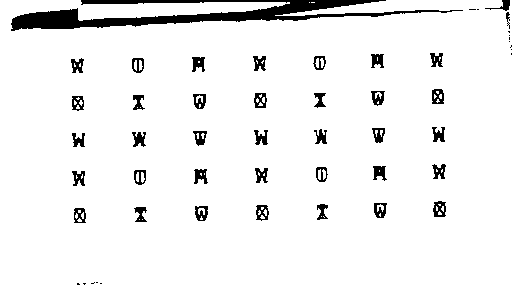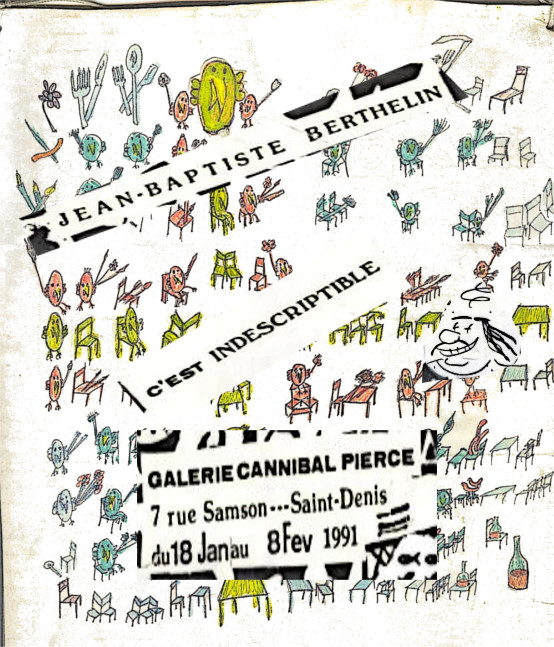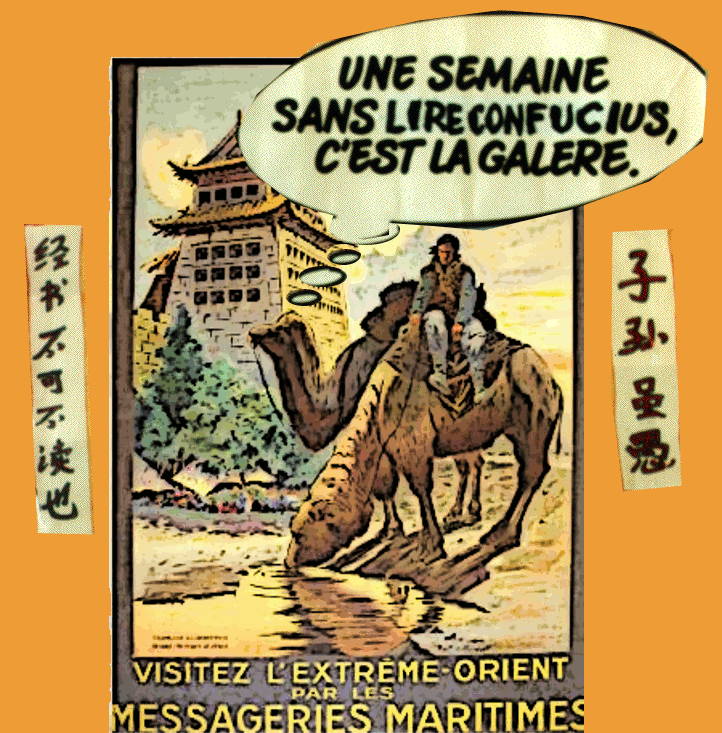One thousand and one descriptors for the undescribable
Jean-Baptiste Berthelin,
CNRS-LIMSI.

en français
initially published in
Æsthetica Nova numéro 2, 1991.
(A similar topic is discussed by
Philippe Hamon).
Day before yesterday,
a guest who helped me plan
my next exhibition insisted that I should see my pictures and consider
their texture. Basically, I do not care much for texture, I take it as it flows, I
am never doing any preliminary work on pigments or whatever.
Still, it must count. Let us see it with
Pictagores. Here we have Pictagore # 5, rather than a
definition.

Where do Pictagores come from? They illustrate an old truth,
or perhaps, they reflect it: Pythagore cannot have designed his well-known table the
way we see it now. One thing we know for sure: the modern use of zero was unavailable
to him. One thing we can guess: many Pythagorean tables were written in Roman numbers.
Someone truly naive would just do so, write a table in Roman
numbers "and see what happens", but what would happen? Numbers would be interpreted by
a compelling automatism:
|
|
V
|
X
|
XV
|
XX
|
XXV
|
XXX
|
XXXV
|
XL
|
|
yield
|
5
|
10
|
15
|
20
|
25
|
30
|
35
|
40
|
which amounts to nothing. To feel the texture of the Pythagore of old times, you must
keep the syntax of Roman numerals, while disposing of the too obvious semantics by
which "V" = "five" = "5" and so on.
Now a well-known method for eliminating semantics is to mask
meanings. The same naive person could produce this awkward Pictagore:
|
this
|
Gif
|
Orsay
|
Laplace
|
Gif-Robinson
|
Robinson
|
|
is
|
Orsay
|
Gif-Robinson
|
Robinson-Gif
|
Robinson-Laplace
|
Antony
|
|
not
|
Laplace
|
Robinson-Gif
|
Gif-Antony
|
Antony-Orsay
|
Antony-Robinson
|
|
a
|
Gif-Robinson
|
Robinson-Laplace
|
Antony-Orsay
|
Antony-Gif
|
Orly
|
|
Pictagore
|
Robinson
|
Antony
|
Antony-Robinson
|
Orly
|
Orly-Robinson
|
where meanings are indeed masked, but in a nondescript way. One could repair
things: Gif could be represented by any Chinese ideogram, Orsay would be
a horse feeding on hay, Robinson an island, and so on. But
there are simpler ways. When designing a pictogram, the only thing that counts is the
contrast. When Rimbaud says
black
A, white E, red I, green U, blue O,
he relies upon some everyday experience according to which a vowel differs from its
neighbour as much as a colour does. In other cultures, you would find A duck, E
horse, I lion, U cow, O whale or perhaps A turnip, E bean, I sunflower, U
cabbage, O pumpkin; anything goes.
In the Pictagore situation, we must consider many numerals, at
least I, II, III, V, X, XX, XXX, L and C, totalling nine. This could yield a solution
using three shapes, along with three colours. As V and L play a special role, we use a
fourth shape, and and also a fourth colour.
We obtain a
minimalistic pictagore, which is number 4 in the series. Why number
four, and not "one"? Just because of some trouble we have with minimalism. Simplicity
is no virtue for a pictogram. As Wittgenstein would have it, a cat has the shape of
a cat, which does not mean that geometry provides us with a special shape, whose name
would be "cat shape". Similarly, in pictograms, I would rather use a sausage than
a square. That is because a sausage can be distorted in many ways, while remaining a
sausage (a not purely graphic concept). A square, however, once elongated, becomes a
rectangle.
That gives us half the rules of the game, not the most
interesting ones. These rules tell us how to generate a
Cochonfucius (or even an
if-she-dares) to show, by other means, a more or less shocking fact, here: present
Pythagorean tables look like nothing Pythagore could have seen.
One last remark: such rules have no explanatory function.
Quite to the contrary, they have a puzzling effect, going against the interpretive
customs of the observer.
* * *
So why does one have to sabotage interpretive automatisms?
We live among walls, not only "between four walls" but among plenty of walls.
Well, if they could be opened at leisure, if we could cover them with live
chamaeleons, but we do nothing of the sort. We install things against them: hat-racks,
shelves, cupboards, mirrors, computers and so on. A present-day Archimedes, who
prudently remains unnamed, discovered wallpaper. What if Pictagore # 5 would have been
wallpaper?

Almost nothing is changed. If shapes and colours were
used, one could say (to no great avail) that wallpaper is "more comforting" and a
pictagore is "more disquieting". One could as well have it the other way round. Let us
consider 23450/9999 and Pi.
23450/9999 = 2,3452345234523452345234523452345234523452345234523452 ...
Pi = 3,141592653589723238426 ...
Which is comforting? Which is disquieting? One would complain
if a wall lets through the noises of the city. Not so, if one has to stay in a prison
cell for twenty years. So we expect many things from our walls. At least, our
prehistoric ancestors, deep in their caves, found a thousand and one irregularities of
the wall. In the dim light of burned bear fat, those irregularities grew into a
thousand and one living shapes. We, however, are supposed to live between bare walls.
Wallpaper may come to mind. One can also try wise sayings, like you find some in the
house of the Dionysian Carmelite nuns: As we begin to learn, we find it is too
late.
These two styles are supposed to be serious. They are, indeed.
But there is a price to be paid. That is not comforting. Let us examine their flaws.
Wallpaper is neutral, without any content in excess. It is like in a restaurant, where
they would give the customer a beautiful plate along with silverware, only to tell him
that food is a nuisance, be it for silver or for china. It can soil them. It is
esthetically inappropriate. So, please let us not mention food. On the opposite end of
the spectrum, the mural inscription, speaking so brutally, is like having a poster in
the restaurant's toilets, saying that paper is a crucial resource, which one should
try not to waste. Also, it would be esthetically unappropriate to soil paper with vile
matters. Therefore, the customer is urged to use his own hands, for reasons similar to
those which prevented the cook to fill his plate.
My pictographic work relies upon a rejection of both esthetic
systems, one being too refined, the other too crude. This does not mean that I cannot
produce pictures of some refinement, or crudeness. I can coin aphorisms which sound
harder than the Carmelitan ones (This place, the madman says, it has but
three
exits: madness and death, inspired by René Daumal); I can also produce some
kind of
wallpaper
for the garden. What I am looking for is an echo
between these two voices. Let us have another aphorism: A week without reading
Confucius is a miserable week (from a Chinese proverb).
How do I avoid having the sentence flatly exposed on a wall,
like an appeal to the conservation of paper in te restaurant's toilets? That is easily
done. We find the picture of a modest Chinese (or Manchu) herdsman, and try to paste
the sentence over his head. Surprisingly, the sentence appears to be pronounced, not
by the man, but
by his camel. Well done! we do not have flat "philosophy in comics", we have
something better. But what is it ? I do not know for sure.

What happens when the camel emits an opinion about Confucius?
Let us have another example.
Listening to the singer Brassens, you can hear Louis Aragon's
prodigious poem
And love can never be happy, in which he says
since for him Life is but a strange and a painful divorce, and also
I carry you along as if you were a suffering bird, and other, quite moving
verses. Now let us consult the Archives du surréalisme:
André Breton : To which extent does Aragon consider that an erection is
necessary when having sex?
Louis Aragon : A certain amount of erection is necessary. As far as I am
concerned, I have only incomplete erections.
André Breton : Do you find it is a pity?
Louis Aragon : It is like every physical inconvenience, but nothing more than
that. I am not suffering more about it than about being unable to lift a piano.
So I remembered other beautiful verses like
Nothing ever belongs to Man, neither his strength nor his weakness
and even No love ever exists but making us wither, and I felt amused (as a
Brassens fan) and perplexed (as a researcher asking himself about humour). In this
last stance, here is my conjecture: humour is efficient when an obvious or important
fact (as found in the poem) is corroborated by something less brilliant and universal
than expected. So Fritz Zorn, in Mars, says theologians are right, they just
have to make their God evolve from all-embracing to parochial, from infinitely
benevolent to paranoid, from almighty to extremely weak.
In Cochonfucean terms: the
emperor's new clothes mean a naked emperor, stinking garments, borrowed ones, clothing
that even you could afford. Thus, humour
rescues us from idolatry.





